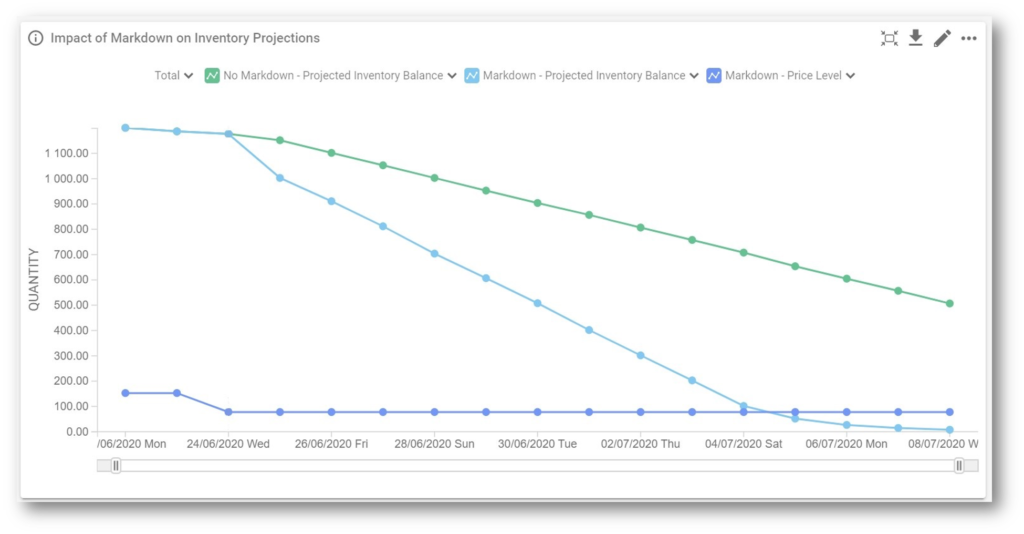For many retailers, markdowns are marred by suboptimal, heavily manual processes and revenue loss. In fact, one study in the U.S. estimated annual loss at $300B—or about 12% of the country’s total retail sales.
There are four primary triggers for markdown processes in retail, including the need to:
- Clear stock to make room for a planned assortment change
- Sell through seasonal items before season’s end
- Move products before their expiration dates
- Jumpstart sales for underperforming products
Retailers often think of markdown as an unavoidable loss center, and it’s true that no amount of good planning could ever eliminate these four triggers entirely. This is especially true for retailers whose assortments are marked by high turnover, seasonality, or expiration dates—such as grocers, for example.
However, advancements in technology have unlocked new opportunities and quick wins that retailers should capitalize on. With a thoughtful strategy and the right markdown optimization solution in place, retailers can transform what was once a painful-to-execute loss center into an automated and proactive opportunity to recoup otherwise lost sales and revenue.
Why Retailers Need Markdown Optimization
We frequently see predictable pain points resulting from poor markdown processes, including burdensome, often spreadsheet-based manual planning and a lack of organizational visibility into which products are marked down and how they impact the business. Grocery retailers in particular often operate without a markdown process of any sort. When store staff realize they have to make room for new items, they simply take old product off the shelves and figure out how to deal with it—whether they have to throw items blindly into an ad hoc discount bin or throw them away entirely. This inefficiency is often far more costly than the loss of margin from markdowns.
It’s virtually impossible to manually identify all overstock risk throughout a large assortment early enough to take proactive steps, much less take the time to calculate which price will best move items while maximizing margin. That’s why many planning teams work from overly broad markdown strategies—for example, a uniform 30% markdown on every item still in stock when it reaches its termination date. When suboptimal planning, execution, and analysis are the norm, financial loss is the only consequence we should expect.
Markdown optimization, on the other hand, automates most of the tasks planners struggle with at retail scale. It uses demand forecasts to identify potential overstock scenarios before those products reach their termination dates and suggests optimal pricing to either clear that stock or maximize margin. The automation it provides moves retailers from a reactive mode, in which the overstocking problem is already obvious by the time it’s identified, toward more proactive, data-driven planning that nips potential overstocking problems in the bud.
The key benefits to moving from manual markdowns to markdown optimization include:
- Maximizing sales and margin through improved timing and more effective discounting
- Reducing spoilage by accelerating inventory turnover while products are still sellable
- Clearing stock for season and lifecycle ends to ensure space for new assortment
- Proactive, highly automated processes and campaign tracking
A markdown optimization solution provides a full understanding of markdown needs only when it is fed a constant stream of high-quality demand forecasts and inventory balances both at the location level (stores and DCs) and throughout the supply chain. Retailers can leverage this supply chain visibility to easily set up a highly automated, proactive markdown optimization process.
How Markdown Optimization Works
A well-planned markdown optimization process calls for five key steps:
- Defining a clear markdown strategy
- Accurately identifying the items that should be marked down
- Optimizing markdown prices in line with the markdown strategy
- Creating the markdown campaign
- Monitoring campaign performance and analyzing for insights
Listed out like this, there’s a lot of work to be done. Fortunately, a markdown optimization solution like the one provided by RELEX automates the majority of these tasks, allowing planners to focus their attention on campaign performance insights that will help them continuously improve outcomes going forward. Let’s take a look at each step in a bit more detail.
1. Defining a Clear Markdown Optimization Strategy
Without a clear strategy in place, markdown processes tend to fall into a reactive mode rather than a proactive one. Once you’ve set clear rules and constraints, though, markdown optimization can automate enormous amounts of difficult, time-consuming work, ultimately saving planner time while improving campaign outcomes. The two most important elements to define are the pricing strategy and markdown plan and goals.
A good pricing strategy is detailed work, and it must define the minimum and maximum markdown rates allowed as well as the level of optimization desired. Markdown goals are a higher-level decision: should optimizations be calculated to maximize margin or to clear all remaining stock by the campaign’s termination date? For both pricing strategy and markdown plan and goals, the solution’s flexibility is critical. Planners should be able to optimize pricing at any level—whether product, product group, location, or even product-location—and change campaign goals as necessary to adjust to needs as they develop.
2. Identifying Markdown Items Quickly, Accurately, and Automatically
Retailers who attempt to manually identify products without the aid of automation often find themselves in a situation where the product balance is already a problem before they can tag it for markdown. As a result, products may only get marked down after they’ve already reached their termination date, when the need to clear space for new inventory is urgent.
Inventory projections are an invaluable tool that combine sales forecasts and inventory balances to show how balances will develop in the future. RELEX markdown optimization provides months-long visibility into inventory projections, making it easy to identify which products must be pushed through the supply chain or out from store locations well before product termination dates. Perhaps more importantly, it does this without any human labor. An hours-long manual endeavor becomes an automated calculation based on the latest inventory and forecast data.
3. Optimizing Markdown Prices in Line with the Markdown Strategy
A markdown optimization solution should also automatically calculate the optimal price for the items identified for markdown. These calculations follow the rules and constraints established in the markdown strategy (minimum and maximum price changes, level of optimization, etc.) as well as the campaign goal (maximizing margin or clearing stock by the termination date).
RELEX’s markdown solution estimates price elasticity by using machine learning to pull from past campaigns and price changes for a given product or product category. The ability to model elasticity at higher levels of aggregation may be helpful for slow-moving categories with sparse data at the product-location level.

4. Turning Automated Recommendations into Active Campaigns
A markdown optimization solution provides planners with a daily exception view that displays 1) the items underperforming their sales targets and 2) the items with high projected stock balances as they near the end of their product lifecycle. For each of those products, the exception view includes the optimal price that caters to the company’s markdown strategy.
A planner using RELEX’s solution, for example, only needs to review the list of product-locations identified for markdown and their proposed price changes, then accept or reject those recommendations to automatically create new markdown campaigns. The solution also provides the flexibility to easily edit recommendations by manually adding or removing specific product-locations from a campaign. Once the campaign is accepted, the system automatically communicates the new markdown prices to stores to be implemented.
5. Monitoring Campaign Performance for Insights
When markdown planning and execution is manual, campaign monitoring sometimes falls to the wayside as planners shift their focus to more urgent tasks. Markdown optimization facilitates campaign performance analysis through dashboards that provide visibility into a number of important metrics, such as inventory projections, projected end balances by termination dates, or a comparison of target vs. realized gross profit and margin.
Exception views highlighting underperforming campaigns allow planners to quickly adjust plans and re-run optimizations to ensure they reach their targets. Campaigns that perform well, on the other hand, provide planners with valuable insights to adjust pricing rules and further improve future campaign performance.
Markdown Optimization Drives Measurable Results
We believe markdown optimization drives the strongest results when it’s delivered by retail optimization software that is:
- Timely, using integrated, real-time access to forecast and inventory balance data to create inventory projections
- Optimized through price elasticity calculations
- End-to-end, so that data processing, recommendations, and planner actions take place within the same system
- Automated, yet flexible enough to accommodate different pricing tactics
RELEX’s markdown optimization solution delivers exceptionally quick time-to-money because it is a fully integrated component of our forecasting and replenishment software. Because most of the data required to stand up the markdown optimization is already in the RELEX system, the solution can be up and running within two months. The financial impact can be seen almost immediately after implementation.
For example, Finland’s leading bookseller, Suomalainen Kirjakauppa, saw a 133% increase in inventory turnover for their marked down items after implementing markdown optimization. This improved turnover eliminated their slow-moving stock and created much-needed space for new titles. They saw 94% higher sales than were projected without markdown and 4x the sales quantity for products included in markdown campaigns. Other customers have seen similar success, with 15-20% lower end-stock balances and 4.9% margin growth.
With the right technology and approach in place, retailers reap the benefits of a proactive, largely automated markdown optimization process that conserves planner resources while delivering stronger results.




